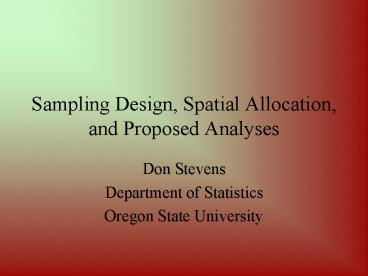Sampling Design, Spatial Allocation, and Proposed Analyses - PowerPoint PPT Presentation
1 / 26
Title:
Sampling Design, Spatial Allocation, and Proposed Analyses
Description:
... populations exist in a spatial matrix ... Spatial Properties Of Reverse Hierarchical ... Assess spatial balance by variance of size of Voronoi polygons, ... – PowerPoint PPT presentation
Number of Views:55
Avg rating:3.0/5.0
Title: Sampling Design, Spatial Allocation, and Proposed Analyses
1
Sampling Design, Spatial Allocation, and Proposed
Analyses
- Don Stevens
- Department of Statistics
- Oregon State University
2
Sampling Environmental Populations
- Environmental populations exist in a spatial
matrix - Population elements close to one another tend to
be more similar than widely separated elements - Good sampling designs tend to spread out the
sample points more or less regularly - Simple random sampling (SRS) tends to result in
point patterns with voids and clusters of points
3
Sampling Environmental Populations
- Systematic sample has substantial disadvantages
- Well known problems with periodic response
- Less well recognized problem patch-like response
- Inflexible point density doesnt accommodate
- Adjustment for frame errors
- Sampling through time
4
Random-tessellation Stratified (RTS) Design
- Compromise between systematic SRS that
resolves periodic/patchy response - Cover the population domain with a randomly
placed grid - Select one sample point at random from each grid
cell
5
RTS Design
- Does not resolve systematic sample difficulties
with - variable probability (point density)
- unreliable frame material
- Sampling through time
6
Generalized Random-tessellation Stratified (GRTS)
Design
- Design is based on a random function that maps
the unit square into the unit interval. - The random function is constructed so that it is
1-1 and preserves some 2-dimensional proximity
relationships in the 1-dimensional image. - Accommodates variable sample point density,
sample augmentation, and spatially-structured
temporal samples.
7
(No Transcript)
8
Spatial Properties Of Reverse Hierarchical
Ordered GRTS Sample
- The complete sample is nearly regular, capturing
much of the potential efficiency of a systematic
sample without the potential flaws. - Any subsample consisting of a consecutive
subsequence is almost as regular as the full
sample in particular, the subsequence. -
, is a spatially well-balanced sample. - Any consecutive sequence subsample, restricted to
the accessible domain, is a spatially
well-balanced sample of the accessible domain
(critical for sediment sample).
9
Spatially Balanced Sample
- Assess spatial balance by variance of size of
Voronoi polygons, compared to SRS sample of the
same size. - Voronoi polygons for a set of points
- The ith polygon is the collection of points in
the domain that are closer to si than to any
other sj in the set.
10
(No Transcript)
11
(No Transcript)
12
(No Transcript)
13
Sampling Through Time
- Detection of a signal that is small relative to
noise magnitude requires replication - Spatial replication (more samples per year)
addresses spatial variation - Need temporal replication (more years) to address
temporal variation - Detection of trend in slowly changing status
requires many years
14
Sampling Through Time
- Repeat sampling of same site eliminates a
variance component if the site retains its
identity through time. - Design based on assumption that sediment does
retain identity, but water does not. - Both water and sediment samples have spatial
balance through time, but sediment sample
includes revisits at 1, 5, and 10 year intervals.
15
Proposed Analyses
- Annual descriptive summaries
- Mean values, proportions, distributions,
precision estimates based on annual data - Mean concentration ? confidence limits
- Percent area in non-compliance ? confidence
limits - Histograms
- Distribution function plots ? confidence limits
- Subpopulation comparisons
16
(No Transcript)
17
(No Transcript)
18
Proposed Analyses
- Composite estimation Annual status estimates
that incorporate prior data - Model that predicts current value at site s based
on prior observation - Composite estimator is weighted combination of
mean of current observation and mean of predicted
values based on prior observations - Results in increased precision for annual
estimates - Can also be used to borrow strength from
spatially proximate data
19
Proposed Analyses
- Trend Analyses.
- Need to describe trend at the segment or Bay
level. - Usual approach trend in mean value.
- Also consider trend in spatial pattern, trend
in population distribution, distribution of
trend, and mean value of trend. - Trend analyses will exploit repeat visit pattern
for sediment samples.
20
Proposed Analyses
- Space-Time Models
- Use random field approach to account for
correlation through space and time - Panel structure (repeat visits) in sediment
sample is a good structure to estimate space-time
correlation - Long-term need 10 years to get sufficient data
to estimate model parameters
21
Proposed Analyses
- Bayesian Hierarchical Models
- Good way to incorporate ancillary information
into status estimates - E.g., loading estimates, flow data, metrological
data - Distribution of response is modeled as a function
of parameters whose distribution in turn depends
on ancillary data, hence, hierarchical
22
Proposed Analyses
- Spatial displays
- Contour plots
- Perspective plots
- Hexagon mosaic plots
- Multivariate displays
23
(No Transcript)
24
(No Transcript)
25
(No Transcript)
26
(No Transcript)































